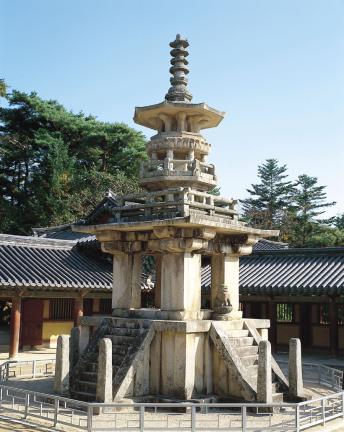경주 불국사 다보탑
| 경주 불국사 다보탑 Dabotap Pagoda of Bulguksa Temple, Gyeongju |
|
 경주 불국사 다보탑, 국가문화유산포털, 문화재청. |
|
| 대표명칭 | 경주 불국사 다보탑 |
|---|---|
| 영문명칭 | Dabotap Pagoda of Bulguksa Temple, Gyeongju |
| 한자 | 慶州 佛國寺 多寶塔 |
| 주소 | 경상북도 경주시 진현동 불국로 385 |
| 지정(등록) 종목 | 국보 제20호 |
| 지정(등록)일 | 1962년 12월 20일 |
| 분류 | 유적건조물/종교신앙/불교/탑 |
| 시대 | 통일신라 |
| 수량/면적 | 1기 |
| 웹사이트 | 경주 불국사 다보탑, 국가문화유산포털, 문화재청. |
|
|
|
해설문
국문
대웅전과 자하문 사이에 석가탑(불국사 삼층석탑, 국보 제21호)과 동서로 마주보고 있다. 원래 이름은 다보여래상주증명탑(多寶如來常住證明塔)이다. 과거의 부처인 다보불(多寶佛)이 현재의 부처인 석가여래가 설법할 때 옆에서 옳다고 증명한다는『법화경』의 내용을 두 탑으로 구현한 것이다. 석가탑이 우리나라의 일반형 석탑을 대표한다면 다보탑은 특수형 탑을 대표한다.
두 탑은 형태가 전혀 다른 비대칭이지만, 양 탑의 바닥돌과 몸돌의 높이가 같아 대칭의 조화를 이루고 있다. 다보탑의 바닥은 십(十)자를 기본으로 사방에 돌계단을 설치하고 8각으로 몸돌과 난간을 둘러 층수를 헤아리기 어렵다. 계단에도 본래 난간이 있었던 것으로 보이며 네 모서리에 사자가 있었으나, 지금은 한마리만 남아 있다. 4각, 8각, 원을 한 탑에서 짜임새 있게 구성하고 각 부분의 길이·너비·두께를 일정하게 적용하였다.
1925년경에 일본인들에 의해 완전 해체·보수가 있었는데, 이때 탑에서 불상을 포함한 사리장엄구(舍利莊嚴具)*가 발견되었다는 짧은 기록만 있을 뿐, 유물의 행방조차 알 수 없다.
다보탑의 건립 시기는 불국사가 창건된 통일신라 경덕왕 10년(751)으로 추측된다. 석가탑에서 발견된 기록에 의하면 고려 현종 15년(1024)에 수리가 있었음을 알 수 있다. 목조건축의 복잡한 구조를 단순하게 돌로 만들어낸 뛰어난 작품으로 8세기 통일신라 석조미술의 정수(精髓)를 보여준다.
- 사리장엄구(舍利莊嚴具) : 사리함과 사리병을 비롯해 사리를 봉안하는 모든 장치
영문
This stone pagoda, known as Dabotap (“Pagoda of Abundant Treasures”), is presumed to date to Bulguksa Temple’s establishment in the mid-8th century during the Unified Silla period (668-935). This pagoda represents the Buddha of the past, Prabhutaratna, and forms a pair with the adjacent stone pagoda, which represents the Buddha of the present, Sakyamuni.
This pagoda’s exceptionally ornate design is based on a description in the Lotus Sutra of a pagoda enshrining Prabhutaratna that arose from the ground during Sakyamuni’s Lecture at Vulture Peak. The pagoda consists of a base with stairs and flagpole supports, multiple stories consisting of pillars and roof stones, and a tall decorative top. The bottom part of the pagoda is overall square in shape, while the upper part is octagonal. Some of the stories have balustrades.
Dabotap has been dismantled for repair and restoration four times in its history. During the Japanese colonial period (1910-1945), a repair by Japanese authorities led to the discovery of a reliquary with two Buddhist statues, but the whereabouts of these precious relics is still unknown. There was also a guardian lion at the top of each of the four stairs, but three were stolen by the Japanese.
- Guarding the top of each of the four stairs at the base were stone lions, but only one now remains because the rest were stolen by the Japanese.
- As opposed to its pair Seokgatap Pagoda, which has a typical Korean stone pagoda design, the design of Dabotap Pagoda is unusually ornate. This design is based on a description in the Lotus Sutra of a pagoda enshrining Prabhutaratna that arose from the ground during the Buddha’s Lecture at Vulture Peak. The pagoda consists of a base with stairs and flagpole supports, multiple stories consisting of pillars and roof stones, and a tall decorative top. The bottom part of the pagoda is overall square in shape, while the upper part is octagonal. Some of the stories feature balustrades. Guarding the top of each of the four stairs at the base were stone lions, but only one now remains because the rest were stolen by the Japanese.
- A pagoda is a symbolic monument enshrining the relics or remains of the Buddha. Although not all pagodas contain the true remains, they are nonetheless worshiped as sacred places that enshrine the Buddha.
- The pair of pagodas located in the courtyard of Bulguksa Temple’s main worship hall are meant to symbolize the Buddha of the present, Sakyamuni, and a Buddha of the past, Prabhutaratna (Buddha of Abundant Treasures), who appears to verify the truth of Sakyamuni’s teachings in the Lotus Sutra. The pagoda to the west (left) is known as Seokgatap meaning “Pagoda of Sakyamuni,” while the one to the east (right) is known as Dabotap, meaning “Pagoda of Abundant Treasures” in reference to Prabhutaratna. The past is symbolized by the east, the present by the center, and the future by the west. The realm of the future is symbolized by the adjacent Geungnakjeon Hall.
- Dabotap Pagoda is presumed to have been built during the Unified Silla period (668-935) around the time Bulguksa Temple was founded in the mid-8th century. It was dissembled and repaired in 1024 following a series of large earthquakes which had made the structure unstable. During the Japanese invasions of 1592-1593, the pagoda collapsed and was reassembled and repaired. In 1925, during the Japanese colonial period, the pagoda was dissembled and gently repaired by the Japanese authorities. At this time, a reliquary with two Buddhist statues was discovered inside, but it is unknown where they were taken. From 2002-2010, the pagoda underwent an extensive survey and restoration.
3D Model